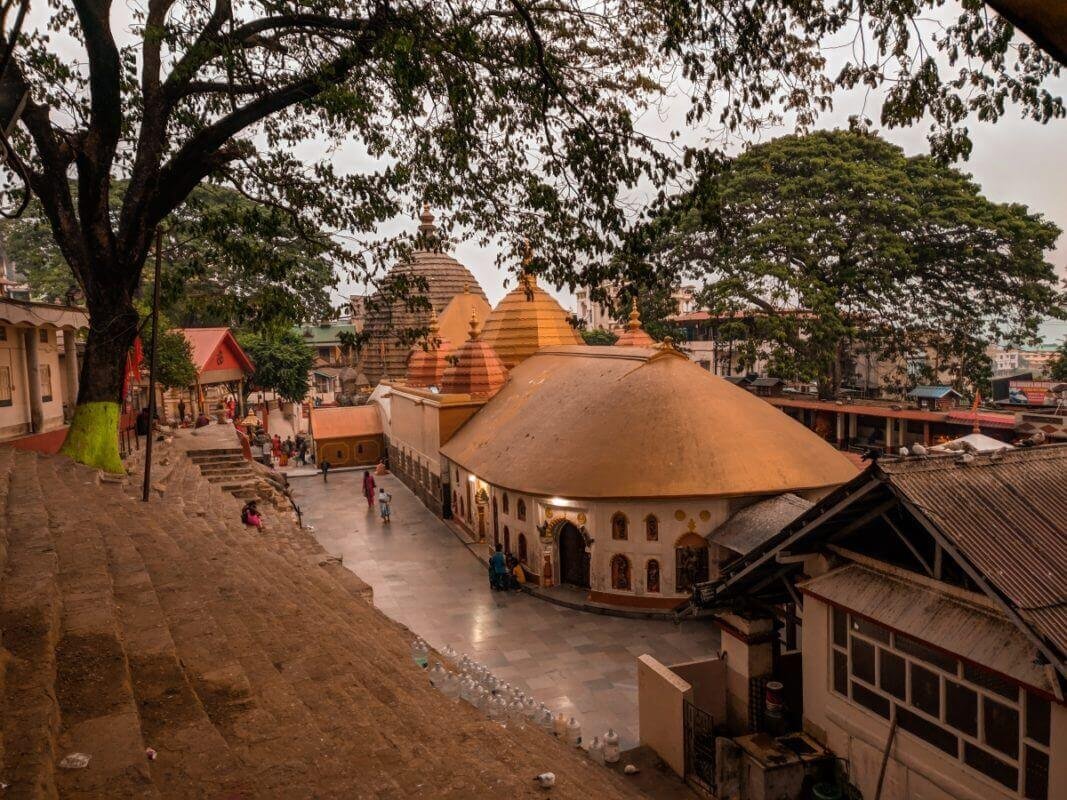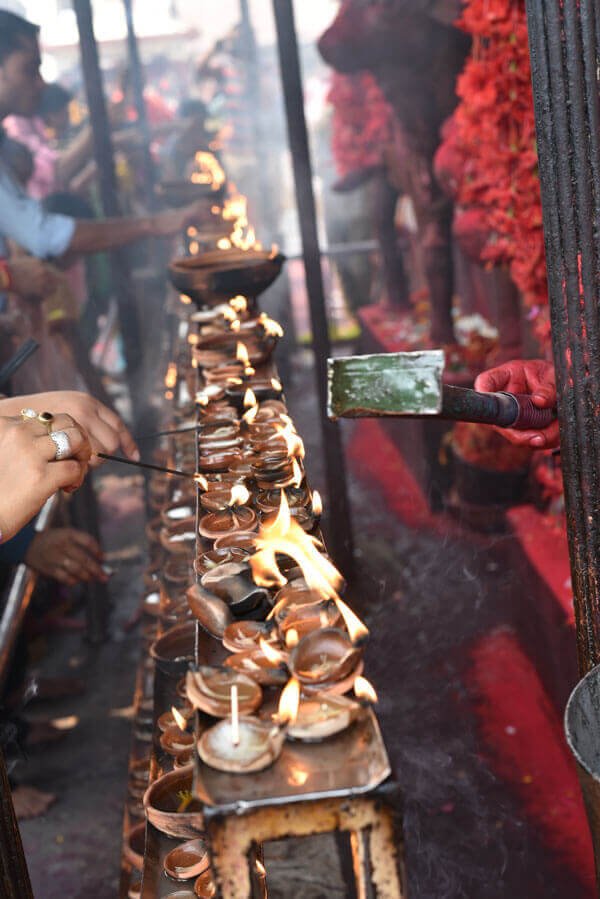Why visit to Ma Kamakhya temple, Guhawati is special?
Posted on April 20, 2019 by Ghoomophiro

India is the land of temples. A number of spectacular temples are of religious importance and, even if you are of a secular orientation of mind, amazing architectural works and sites that boost of amazing legends. Ma Kamakhya Temple of Guwahati in Assam is one such temple. It is one of the most important tourist attractions in Guwahati.
Ma Kamakhya Temple is one of the oldest of the 51 Shakti Pithas and an important place of pilgrimage, especially among Tantric worshippers.
Today, Ghoomophiro is going to tell you all there is to tell you about this amazing temple:
Location of Ma Kamakhya Temple
Ma Kamakhya Temple is located in a temple complex on Nilachal Hill in the western part of Guwahati city in Assam, India. The complex has ten individual temples dedicated to the ten Mahavidyas of Saktism: Kali, Tara, Kamakya, Sodashi, Bhuvaneshwari, Matangi, Bhairavi, Chhinnamasta, Bagalamukhi, Kamalatmika, and Dhumavati.

Best time to visit Ma Kamakhya Temple?
An important event is Ambubachi Mela which is celebrated during the monsoon season around the middle of June. It is thought of as the celebration of the yearly menstruation course of goddess Kamakhya. Another important event is the navratras when Durga Pooja is held during a five-day long festival. However, the monsoon might cause transit problems. Guwahati has the most pleasant weather during the winter months from October to March. The temple is open all days of the year from 08:00 A.M. to 1:00 P.M. and 2:30 P.M. to 5:30 P.M. The temple is less crowded during the afternoon hours.
How to reach Ma Kamakhya Temple?
Guwahati boosts of its own international airport – Lokpriya Gopinath Bordoloi International Airport. It also enjoys brilliant rail and road connectivity. Once in Guwahati, you can catch a bus from the main bus stand of the city that takes you to the temple. The city also has good taxi services.
Where to stay?
Guwahati offers hotels and accommodations services of all budgets and forms.
The mythological importance of Ma Kamakhya Temple
According to an important legend of Hinduism sourced from Kalika Purana, this was the place where Sati and Shiva held meetings for amorous relations.
The origin of worship ‘Shakti’ at the site is associated with the tragic end of GoessSati, the wife of the ascetic god Shiva and daughter of the Puranic king Daksha. Daksha, who was not pleased with his daughter’s choice of husband, did not invite Shiva or Sati when he performed a grand Yajna for all the deities. Enraged, Sati threw herself into the fire, knowing that this would make the sacrifice impure. Griefened and enraged by the loss of his wife, Shiva put her body over his shoulder and began his tandava – Shiva’s great dance of cosmic destruction. The other Gods, afraid of the destruction of the world, implored Lord Vishnu to pacify Shiva.

Vishnu sent his discus Sudarshana chakra to cut off, one by one, 51 parts of the corpse of Sati until Shiva was left without a body to carry. Upon noticing this, Shiva calmed down and settled to do Mahatapasya (great penance). ]Shive would later marry reincarnation of Goddess Sati, Parvati.
The places where each of 51 pieces of Sati’s corpse are known as ‘Shakti Peeth’. Ma Kamakhya temple is one such Shakti Peeth. It is the peeth where Sati’s yoni (‘womb’) fell to Earth. The name ‘Kamakhya’ figuratively means ‘renowned goddess of desire’.

Kalika Purana counts Ma Kamakya temple among one of the four primary shakti peeths. The other three include – the Vimala Temple within the famous Jagannath Temple complex in Puri, Odisha; Tara Tarini, Sthana Khanda, near Brahmapur, Odisha (that originated from the breasts of the Corpse of Mata Sati) and Dakshina Kalika in Kalighat, Kolkata, in the state of West Bengal, that originated from her limbs.
In other legends, the temple has been associated with the goddess Kali.
History of Ma Kamakhya Temple
Though the site might have attracted the pilgrim much earlier, the earlier part of the architecture dates back to ninth century A.D. It is in tenth century A.D. that the temple grew in prominence under later Palas, especially gaining the popularity among the tantric worshipers. Kalika Purana was composed around this period too. The temple was destroyed by invaders in the 16th century and was reconstructed by rulers of Koch density.
Entry Fee
The entry is free of cost but you can get a VIP ticket for some fee if you wish to avoid long queues.
The architectural design of Ma Kamakhya Temple
The Ma Kamakya temple consists of the following four chambers: one garbhagriha and three mandapas. These madapas are locally called calanta, pancharatna, and natamandira aligned from east to west.
The garbhagriha is the main part of the temple. It is a sort of cave below the ground level. It is rather small and dark (only a couple of lamps provide the light) and is reached by narrow steep stones starting from the main hall. The path is very narrow and no more than two or three people can pass it side by side.
The garbhagriha has no image or sculpture. All it has is Yoni or a vagina-shaped rock fissure about 10 inches deep, It usually remains covered with the flowers and other offerings, that is considered as the main deity This fixture keeps getting filled again and again with an underground water spring which pilgrims often carry back as a sort of prasad.

The temple is just one of several in the complex all of which are devoted to goddesses.
Food and Souvenirs
Like all major Hindu temples, Ma Kamakya temple boasts of shops outside its premises which sell souvenirs and different kinds of Prasad.
Things to remember
Though cameras and mobiles are allowed, photography is strictly forbidden. And of course, like most Hindu temples, shoes are not allowed. Though there is no dress code and you can wear western clothes, too much show of skin might attract frown from some of the narrow-minded pandas. Pandas, by the way, are the priests in orange-colored robes who offer their services at the place. Also, it might be disturbing to many, including Hindus, buts sacrifices of goats are regularly made in the temple complex and it can be a gruesome sight.
Conclusion
In a time where feminism of the country has finally learned to question the taboos surrounding the mensuration, a temple devoted to the ‘bleeding goddess’ (as Ma Kamakya is locally called) and that celebrates through a mela the annual mensuration cycle of a goddess gains great importance. One is forced to wonder whether the temple authorities forbidding the entry of mensurating women citing their ‘impurity’ are coloring Hinduism according to their own narrow-mindedness.
That is all from us regarding the most famous temple of Guwahati. We hope you enjoy this post.





I have heard a lot about Maa Kamakhya temple from my mom..but I never got a chance to visit..hope to visit there soon and take blessings from Maa
What an amazing write up. Interesting till the end. Wish to visit some day and take blessings from goddess Karmakhya.
I have visited this fascinating temple twice, and I can really feel an amazing energy here. It’s wonderful that this religious institution promotes feminism.
That’s a really wonderful insight into the history and architecture of this beautiful temple.
The conclusion questioning the skewed logic of the so called custodians of religion is a real eye opener.
Thanks for sharing detailed information about this temple. I heard a lot about this temple but never get chance to visit. Assam is in our bucket list whenever we plan our trip to Assam we will definitely visit this temple too
Travel Soon!!
Love reading your post. I have also heard many stories behind this temple..one of the Shakti peeth.
I heard a lot about Maa kali’s this temple but never get a chance to visit. Hopefully one day will visit the place.
Amen!!
I am not a theist but I have a soft spot for Shiva and Sakti… Sakti peeths and jyotirlings are places I really wanna visit! Loved reading this!
it was great to know the interesting story behind this temple. Guhuwati is a beautiful place and I would love to visit again 🙂
Thank you!! Yes north-east overall is beautiful.
Excellent way of describing, and good paragraph to take information on the topic of my presentation focus, which i am going to convey in university.